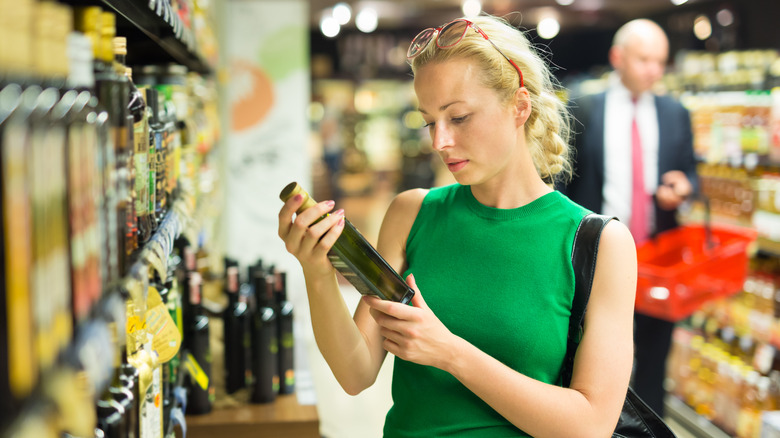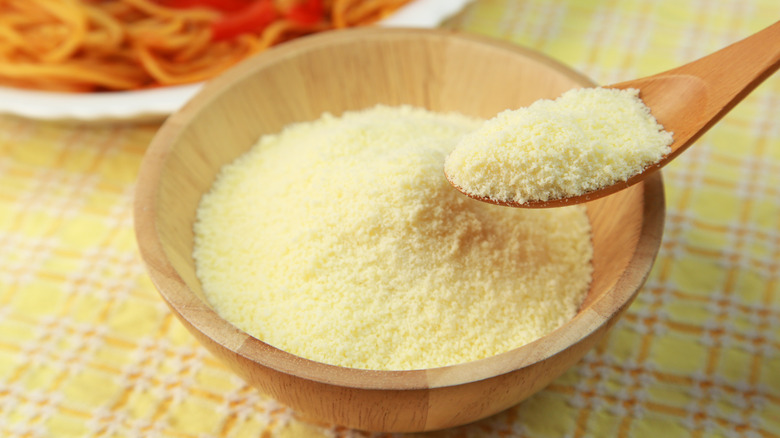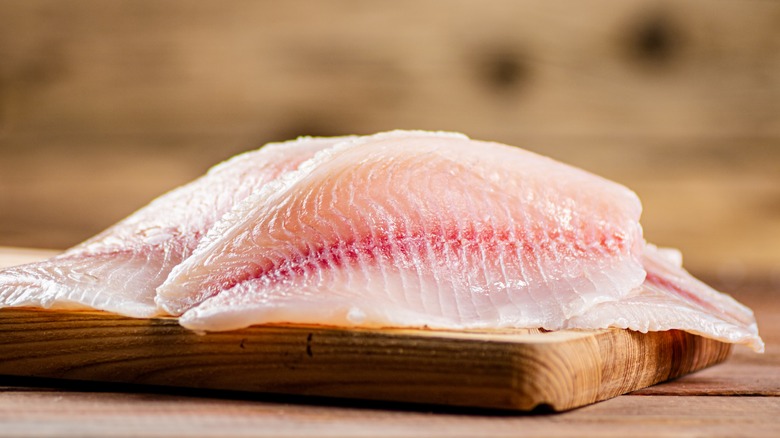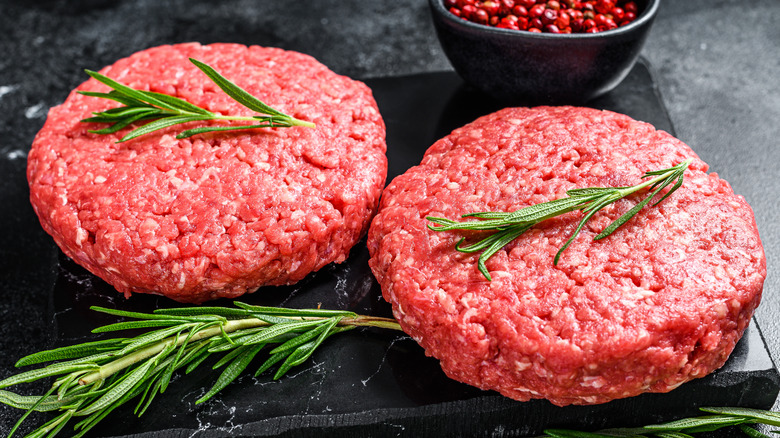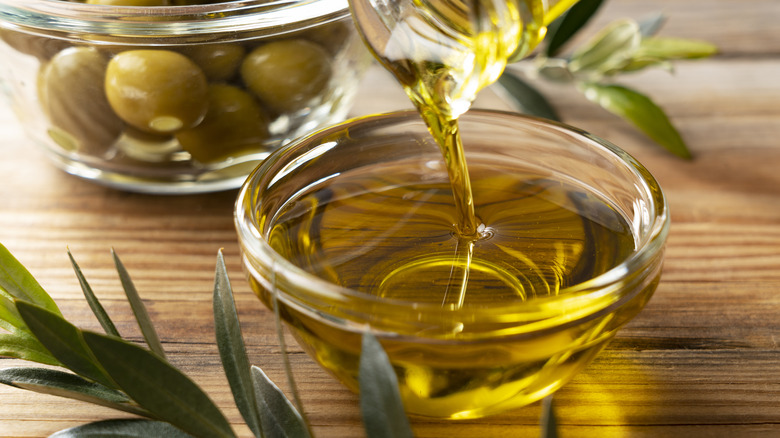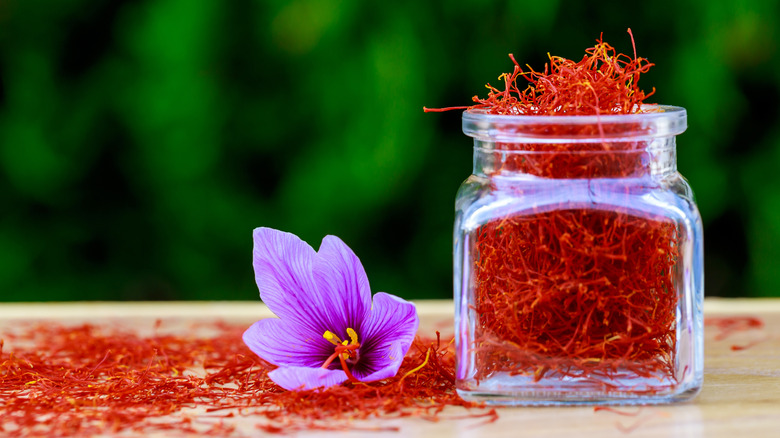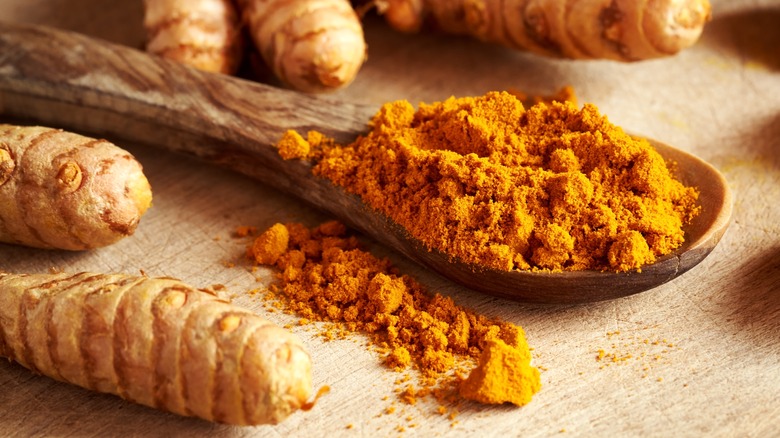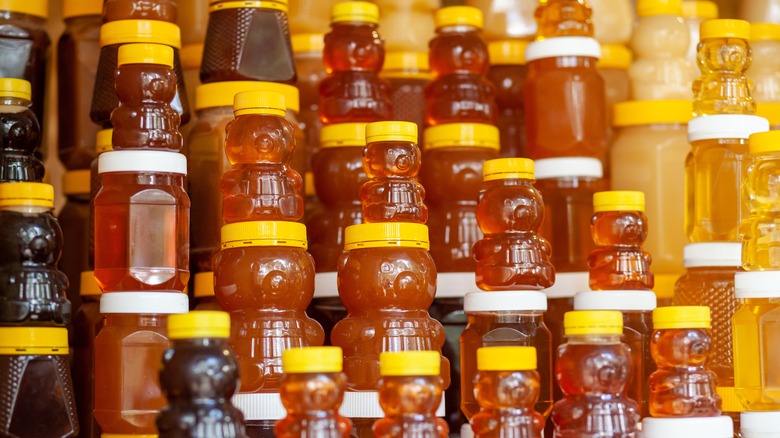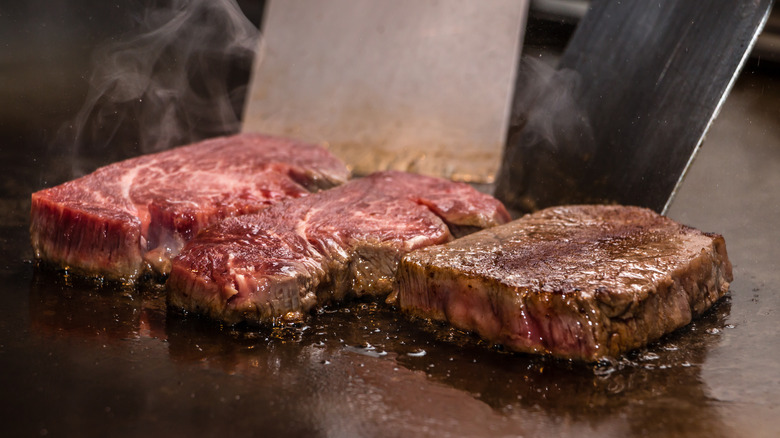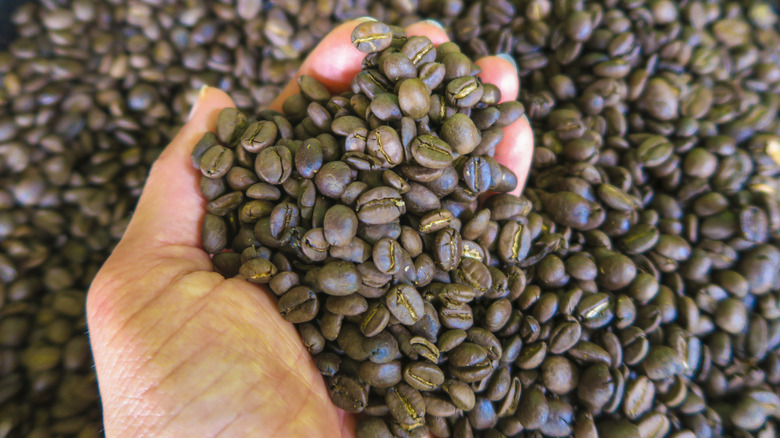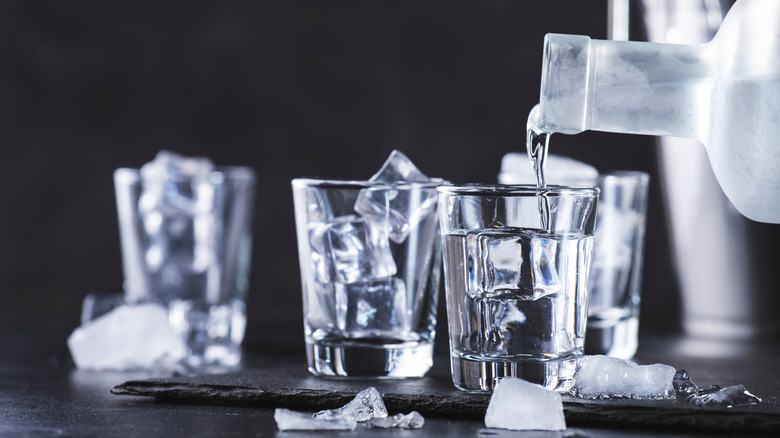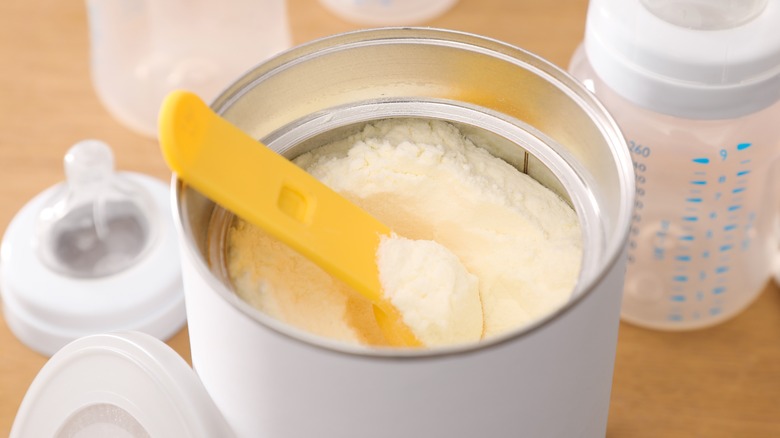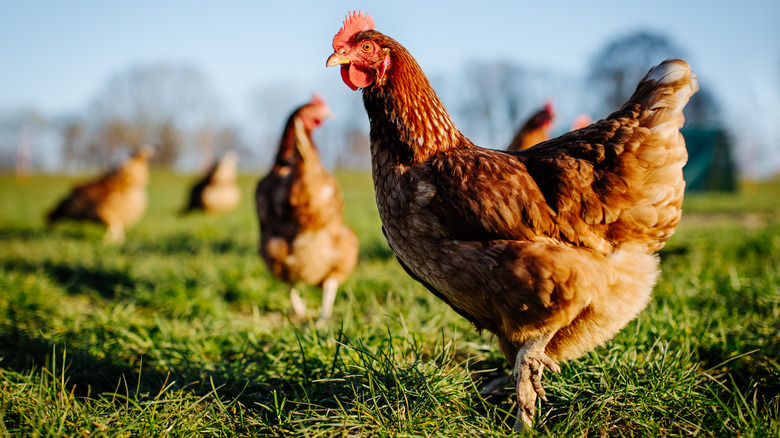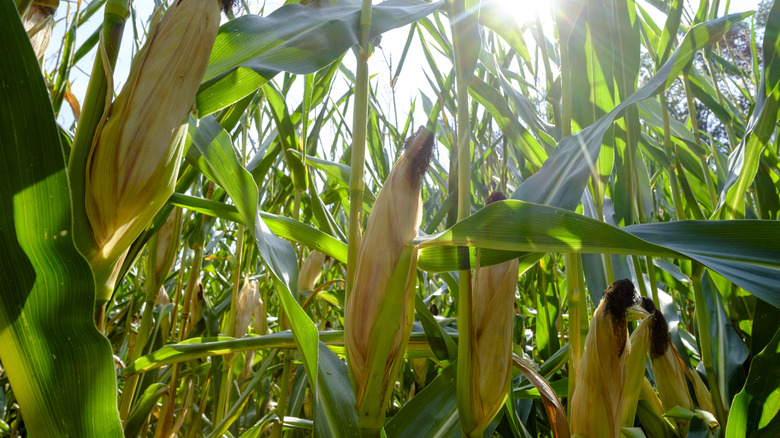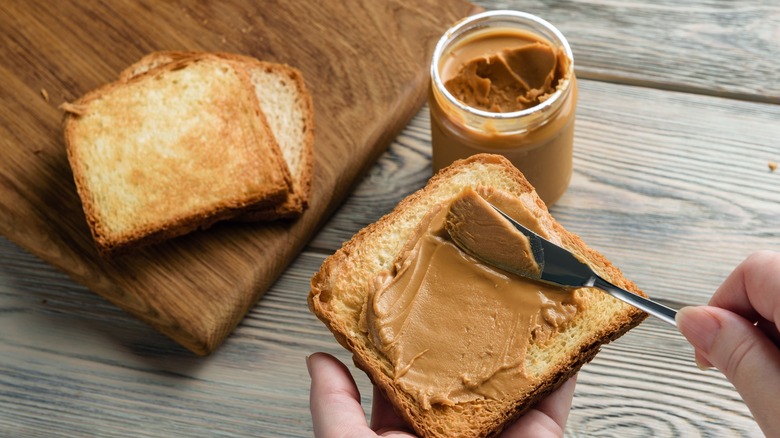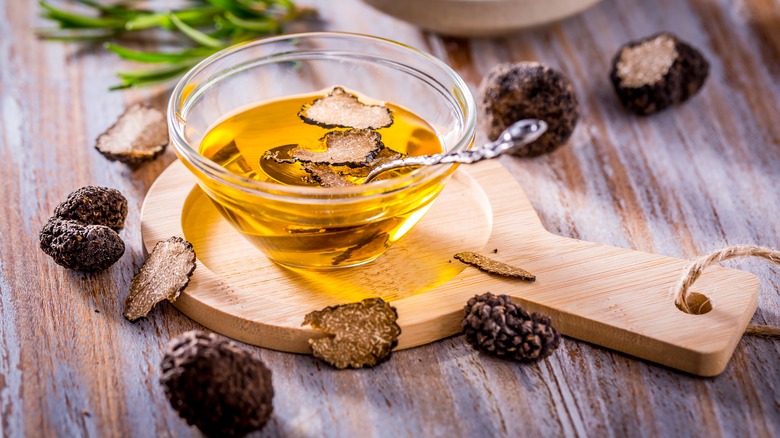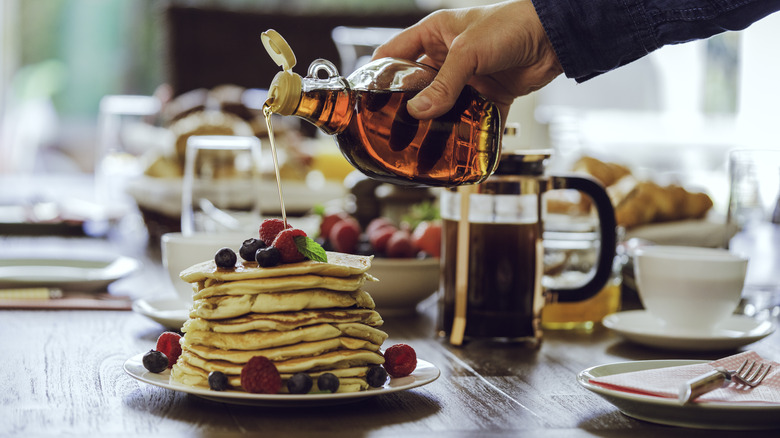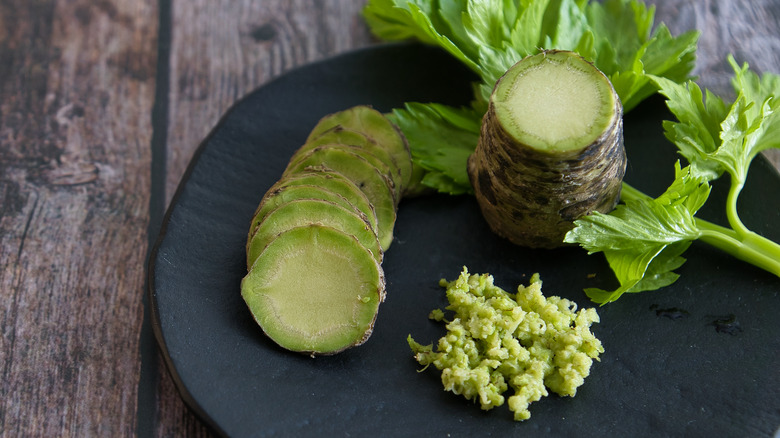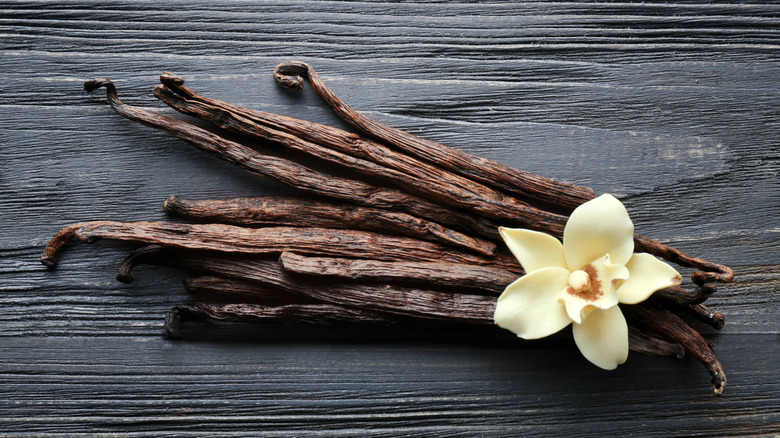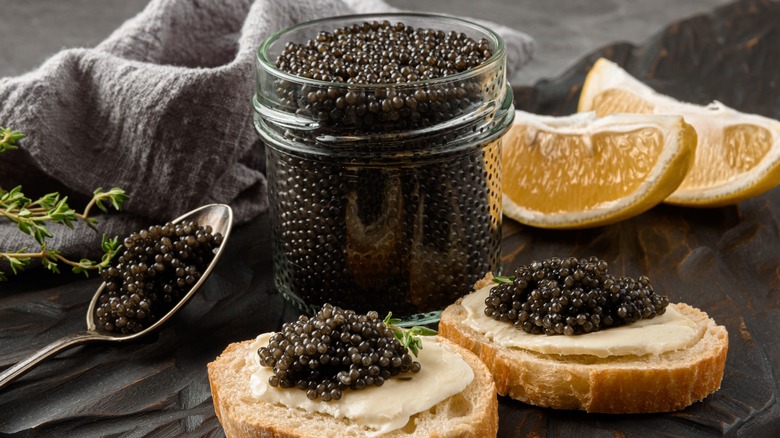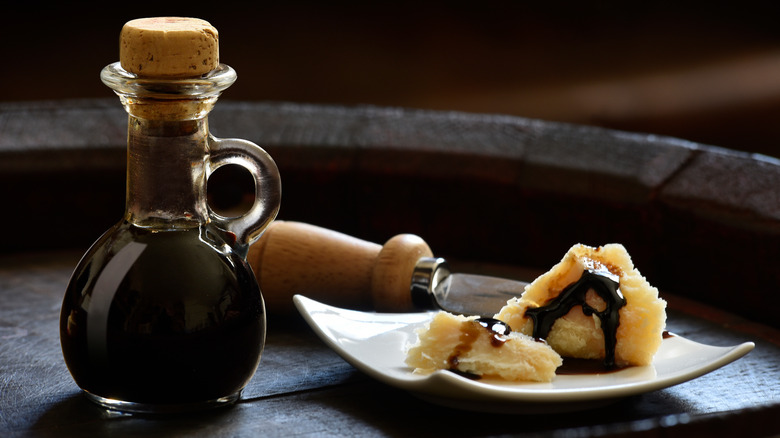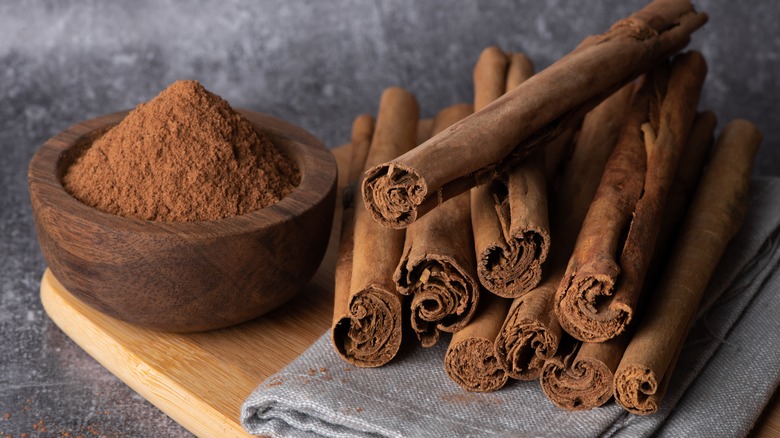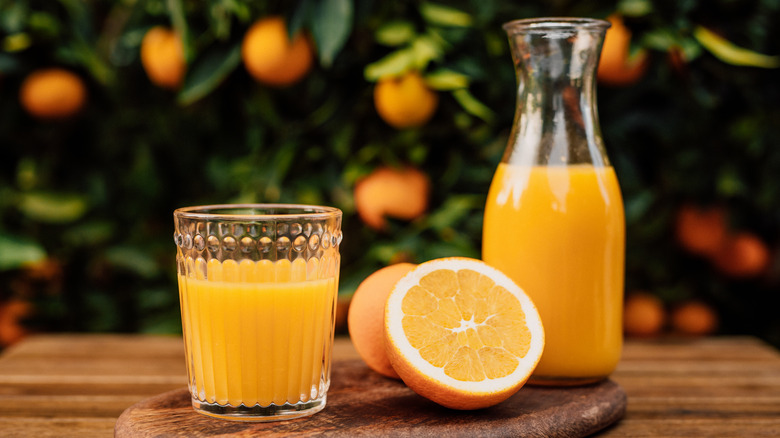Sneaky Ways You're Being Tricked Into Buying Fake Food
You've heard of credit card fraud, mail fraud, and tax fraud, but you might not have heard of "economically motivated adulteration," or in simpler terms, food fraud. Yes, criminals are after not only your bank account and your credit card but also the money you'll shell out for Parmesan cheese or Kobe beef. Don't worry. They're not wiring the contents of your refrigerator to an account in Nigeria or anything, but some are taking the ingredients right out of the food you buy at the grocery store.
Their reasons for this are — as you might have guessed based on the U.S. Food and Drug Administration's unnecessarily cryptic term — motivated by money. Manufacturers are always looking to cut costs, but there are a few less-than-virtuous operators who will adopt profoundly upsetting ways to the point that the food you buy isn't what the label says it is. In some cases, it might contain ingredients that don't even qualify as food. An estimated 1% of the global food industry is tainted by food fraud, according to the FDA.
Food fraud ranges from adding cheap fillers to bring down costs to lying about a product's origins to knowingly putting damaged or dangerous products on store shelves. And yes, it happens here in America, where we don't have great systems in place to monitor all the massive amounts of food that are trucked around the country every single day. Here are some of the more commonly adulterated foods and how they were adulterated.
It's true, that powdered stuff might not really be Parmesan cheese
You've probably always kind of suspected that the yellow powder labeled "Parmesan cheese" that comes in a can and doesn't have to be refrigerated might not be actual Parmesan cheese. Depending on which brand you buy, you could actually be correct. But you probably rather innocently assumed that it was at least some sort of cheese, or failing that, a dairy derivative or, you know, at least food. Well, back in 2016 Bloomberg News reported that Castle Cheese Inc. was plumping up its cans of 100% real Parmesan cheese with ... wait for it ... wood pulp.
Now, you may have seen goats eat wood pulp, so technically it could be described as food, but you are not a goat. Here's the thing, though — the wood pulp that Castle Cheese put in its Parmesan was in the form of cellulose, which is commonly used as an anti-clumping agent in food. Manufacturers aren't supposed to use a lot of it, though — levels shouldn't exceed 2% to 4%, and it shouldn't be put there just to add weight (and therefore profit) to the product. And besides that, Castle Cheese's 100% Parmesan also did not contain any Parmesan (via U.S. Food and Drug Administration). Instead, the company was using cheaper cheeses like white cheddar and mozzarella, though to be fair, most of us can't tell powdered Parmesan from mozzarella after it's melted down into a slice of pizza anyway.
Can you tell the difference between tilapia and sea bass?
When you cook up a nice seafood meal for your significant other, you probably use whatever type of fish the recipe calls for, but let's be real. You can probably buy whatever you want because it's sometimes hard to tell the difference when it comes to what's sold at your local supermarket. To most of us, white fish just looks like white fish, and we count on the grocery store labeling to tell us what we're buying.
Well, seafood suppliers know this, and that's why they sometimes get away with mislabeling a cheaper piece of fish as something more expensive. After all, once it's fried up and drenched in lemon juice, even a professional chef might not be able to identify the species. According to a conservation organization called Oceana (via CNN), roughly 21% of commercially available fish isn't correctly labeled. The group DNA-tested 400 fish samples from restaurants and grocery stores in 24 states and the District of Columbia, according to the 2019 report, so it seems pretty likely this is a nationwide problem. This means when you drop $32 a pound on Chilean sea bass, you might actually be buying tilapia, which sells for less than $10 a pound. In a way, though, this is great news in a time of inflation because it means you can just save some money and buy the tilapia. Your significant other will never know the difference.
That time the Brits unknowingly ate horse meat
Just as you might not be able to tell the difference between tilapia and sea bass, there's a good chance you can't tell the difference between beef and horse meat, either. If you're offended by this insult to your culinary sensibilities, recall that back in 2012 and 2013, the British were eating hamburgers that were 29% horse meat and had been doing so for at least 10 months and possibly up to five years (via The Guardian).
The culprit: Anglo-Irish Beef Processors, which wasn't just someone's backyard slaughterhouse. It was Europe's biggest beef processor. Some of Britain's biggest grocery store chains, including Tesco and Aldi, received and resold the horse burgers, which were evidently made using meat from up to 40 different suppliers. And just in case that isn't gross enough for you, the supplier responsible for adding at least some of the horse meat was also mixing it with previously frozen beef that was so spoiled it was green. But on the plus side, the meat packer saved itself a ton of money, so in the end everyone was a winner. Or maybe just that one meat packer.
Extra-virgin olive oil might not be extra-virgin ... or olive oil
Olive oil has a pretty distinct scent and flavor, but when you compare olive oil with extra-virgin olive oil, well, a lot of people can't really tell the difference. Similarly, you might not be able to tell if your olive oil has been diluted by something else, like canola oil, which is a problem not just because no one wants to spend $17.99 on a bottle of extra virgin olive oil that isn't extra virgin olive oil but also because a lot of us use olive oil for its heart-healthy benefits. We don't want any unknown oils making our olive oil a moot point.
Now, there was a lot of noise about fake olive oil seven or eight years ago, and we've since learned that most of the olive oil sold in the United States is genuine (via North American Olive Oil Association). But there are still some isolated incidents of fake extra virgin olive oil intended for U.S. consumption, as reported by Reuters in 2017. In that incident, the literal mafia was labeling olive oil pomace — the stuff that's leftover after the olives are pressed — as "extra virgin" and exporting it to the United States. That's right, people. The mafia isn't just about guns and drugs anymore. Today's mafia is also an economically motivated adulterer.
Saffron might be bulked up with corn silk
The first time you bought saffron, you were probably surprised to open up that $20 jar and discover that you didn't get 6 ounces of saffron. You instead had 0.06 ounces of saffron, and there aren't enough threads in the jar to see clearly without a magnifying glass.
Pound for pound, saffron is the most expensive spice in the world. If you want to buy a whole pound of it, it will set you back more than $1,500, and that's if you buy the cheap stuff.
If you're going to pay that much money, you want to ensure it's saffron rather than something like, say, corn silk dyed red. Now, it seems grossly unfair that a product that is that expensive could ever be adulterated, but the reason saffron is expensive is because it's incredibly labor intensive to harvest (each flower has only three stigmas, and they must be hand-picked — now imagine how many flowers you would need to make a pound of saffron). So it's actually not that shocking that this particular spice is frequently adulterated. Real saffron is sometimes mixed with corn silk threads or coconut filaments and red dye, though sometimes what you buy doesn't contain any saffron at all. According to Business Insider, Spain reported in 2010 that it exported 190,000 kilograms of saffron, but Spanish farmers said they only harvested around 1,500 kilograms. Hmm, something is deeply wrong with that math.
Basically anything yellow can be passed off as turmeric
Saffron has a pretty unique flavor, but one of the reasons chefs use it is because it also imparts a beautiful, golden color to whatever it is you're cooking, even though saffron itself is red. But at $1,500 a pound for saffron, it's no wonder some people recommend using turmeric instead. Turmeric comes from the root of the Curcuma longa plant, so it's somewhat easier to harvest than saffron. It will also give your food that sought-after bright yellow color.
Unfortunately, turmeric gets adulterated, too. According to retailer Zizira, manufacturers sometimes put dyes like metanil yellow and sudan red into turmeric to give it an even brighter yellow color. They might also mix it with other roots like cassava (which is poisonous in its uncooked form) or Curcuma longa relatives like white ginger and wild turmeric. In some parts of the world, turmeric has even been adulterated with lead chromate, which has a bright yellow color and can cause lead poisoning. So really, if you want your food to be yellow, you could just go with yellow food coloring instead.
Honey is sometimes diluted with corn syrup
If you've ever bought honey from a dollar store, you were probably shocked by the good value and maybe even a little disillusioned by that more expensive honey you've been buying at the grocery store. Look a little closer at the label, though, and you'll see that you're probably not really buying pure honey. You're likely buying blend syrup, which you just thought was honey because it came in a cute bear-shaped bottle.
Blend syrup doesn't even list honey as a first ingredient — the first ingredient is corn syrup, and the second ingredient is honey. But at least you aren't paying a premium, and the manufacturer is being clear(ish) on the label. In other cases, the 100% honey you thought you were buying isn't 100% honey. It's basically blend syrup without the honesty. In fact, according to Insider, honey is the third-most faked food in the world. In 2013, Wired UK reported that American honey is quite often adulterated with corn syrup or rice syrup and might even be flavored with cheap unrefined sugar. And this isn't just something that was true a decade ago, either — according to a more recent Wired UK article, there's plenty of evidence that adulterated honey is still being sold in United States and Canada.
That $200 steak might not really be Kobe beef
Kobe beef is prized for its heavy, sort of weirdly unnatural marbling, which makes it incredibly tender, flavorful, and expensive. If you order Kobe steak in a restaurant, you can expect to pay around $200 for 4 ounces of meat, depending on where you go and whether or not the beef is graded A5 (the highest grade). Naturally, this makes Kobe beef (a variety of Wagyu) big business for American restaurants, but here's the thing: Some American restaurants are playing fast and loose with the definition of "Kobe."
A 2009 Miami New Times article reported some of the steaks sold as Kobe beef in Miami restaurants weren't technically Kobe. In order to qualify for that name, the cattle must be raised in the Hyogo Prefecture in Japan. So it's sort of like buying cheddar that doesn't come from Cheddar ... oh, wait.
Evidently, some restaurants were crying, "We didn't know that!" when it comes to labeling requirements for Kobe beef. And on the surface, it does seem like a rather superficial distinction. After all, basically everyone considers cheddar cheese to be Cheddar cheese, regardless of where it was made. But Kobe beef comes from a specific breed of cattle raised in the Hyogo Prefecture in Japan and must meet certain requirements. It's also closely tracked so that its limited supply can be authenticated. If you're finding Kobe beef to be commonplace, it's probably not the real deal.
Et tu, coffee?
Americans love coffee. So what would you say if you learned that your favorite cup of 100% Arabica isn't 100% Arabica or even 100% coffee? Because when you think about it, if you're just running the grounds through your coffee maker, are you even going to notice that some of those grounds are actually barley?
Well, according to a 2020 study published in the journal Foods, coffee is often adulterated not just with barley and other grains but also with nuts, legumes, and "other vegetables." Some coffee, the authors said, might even be adulterated with much less-edible things like coffee husks and twigs. And this particular problem will probably get worse as climate change reduces the acreage suitable for coffee growing (models predict a shrinkage of around 50% by 2050), and manufacturers and distributors seek to mitigate soaring prices and smaller yields.
In the short term, you can make sure you're getting 100% coffee by buying only whole beans, which can't be adulterated in the same way as the pre-ground stuff (although it's still pretty tough to know whether it's 100% Arabica or Arabica plus something else). And enjoy your overpriced espresso drink from your local coffee shop while you still can ... one day soon it may be more lentil than latte.
Even your vodka might not be real
Most of the adulterated food that reaches the United States and other nations isn't likely to make you sick or kill you. And though obviously economically motivated, food fraud reasons range from "we have to do this to stay in business" to "gimmee more money, consumers!" Typically, though, there isn't anything willfully malicious in food adulteration apart from the obvious desire to pocket more of your already doesn't-go-very-far cash.
Sometimes, though, products are adulterated with things that can harm you. And though these kinds of adulterations are done with money in mind, there's also a much more sinister element to them: profit over human lives.
In 2013, the BBC warned British Christmas shoppers to take care when purchasing certain types of alcohol, particularly vodka. The warning was based on a doubling of the amount of fake vodka that was seized by the government that year, some of which contained industrial alcohol, antifreeze, and chloroform — yes, that stuff they use in the movies to instantly knock a person unconscious (spoiler alert: it doesn't really work like that, but long-term exposure might give you cancer). Consumers buy adulterated vodka because it's cheaper and because they don't know that drinking it can cause long-term health problems like blindness, nerve damage, or even death.
Chinese manufacturers once put melamine in baby formula and other milk products
It's bad enough when unscrupulous manufacturers target young adults at a New Year's Eve party, but when they go after infants, well, that's pretty unforgivable. You might remember the infant formula scandal of 2008, when Chinese manufacturers watered down dairy products in order to "stretch" their supply, then added melamine to give it the requisite amount of protein (or at least, that's the best guess as to why they did it). Melamine, by the way, is the stuff your plastic dinnerware is made out of.
So melamine was in the milk, but then the milk was used to make baby formula, and around 300,000 Chinese babies and kids drank it and developed kidney stones and renal failure. Six of them reportedly died.
Tainted milk products weren't just consumed in China, either — they were also exported to other continents, including parts of Europe and Africa. In 2007, melamine was also found in American pet food.
Fraud can also mean your food doesn't come from where the label says it does
If you buy free-range, pasture-raised, or grass-fed animal products, you pay a premium for food you believe has been raised in humane conditions, and you have to have a lot of faith that the products you buy are what they say they are on the label. Unfortunately, there's sometimes a disconnect between what consumers think is "humane" and what producers think is "humane."
Sometimes, the problem isn't even a matter of breaking the rules. It's just that the rules don't really work the way consumers think they should work. For example, in 2019 a company called Nellie's Free Range Eggs — which sold its eggs in a carton featuring a charming little boy frolicking in a green pasture with some chickens — was facing a lawsuit that alleged the company actually kept its hens in sheds, and that each one had about 1.2 square feet in which to free-range. Nellie's argued that its hens were, in fact, free-range according to the letter of the law, which only requires chickens to have access to the outdoors for a least six hours a day (via JD Supra). The court disagreed, mostly because even if Nellie's eggs were technically free-range according to the law, its website featured advertising that implied they were a lot more free range than the legal standard.
When non-GMO and organic might not be exactly non-GMO and organic
Just as it's hard to know based on the package whether "free-range" means what you think it does, it's also hard to know whether the food you're eating is really organic or non-GMO. For a start, most consumers think "organic" means "grown without pesticides," but it does not. Organic farmers do get to use pesticides as long as they are derived from natural sources like pyrethrins (which are not actually harmless, by the way).
Organic crops also sometimes get contaminated by pesticides that drift over from some other farm, so the presence of synthetic pesticide residue on an organic tomato may or may not mean it hasn't been grown organically. But it's not like organic foods are routinely tested for the presence of synthetic pesticide residue, and therein lies the problem.
Most organic farmers are honest, but any time you have a high-demand, high-value product that looks exactly like a lower-value product, you're going to have one or two businesses tempted to try passing that lower-value product off as the higher-value one. In 2019, for example, a Missouri farmer named Randy Constant was accused of selling $142 million worth of organic grain, the majority of which wasn't actually organic, over several years. He later admitted to the scheme and was convicted after pleading guilty to a single count of wire fraud.
Sometimes, companies knowingly ship products that are contaminated with pathogens
When you have to answer to your shareholders, you have a really big incentive to get product out of the factory and onto the shelf. Manufacturing peanut butter is a costly process that involves growing the peanuts, shelling them, crushing them, mixing them with oil, salt, sugar, and other ingredients, and putting them in a sealed jar. If you get all the way to the last couple of steps and discover that your product has become contaminated with salmonella, what do you do? Throwing all that peanut butter into the trash would put a pretty deep cut into your bottom line.
In 2015, the former president of the Peanut Corporation of America was sentenced to 336 months in prison for shipping peanut butter that either tested positive for pathogens or hadn't been tested for pathogens at all. Peanut Corporation of America products were ultimately linked to a salmonella outbreak that probably sickened around 22,000 people.
It's important to remember that the kind of food fraud that can be harmful to your health is much less common than the type that is simply harmful to your trust (and wallet). Regardless, it's worth knowing that some manufacturers put profit first and consumers second ... and if they can find a way to cheat you out of a little bit of extra change, they just might do it.
There's more than one way to defraud truffle enthusiasts
When some truffle varieties cost over $96,000 a pound, the market is ripe for fraud. Sometimes cheaper species are mislabeled as more expensive ones. Another way you could being tricked is if the truffle oil you're buying at $60 or more a pop relies on synthetic ingredients rather than real truffles.
Nobody wants to pay hundreds or thousands of dollars per pound for highly sought-after truffles only to find that they're eating truffles worth only $16 a pound. However, it can be difficult to know what you're getting from sight alone. The chemicals in truffles vary by species and where they were grown, so scientists can authenticate them with fairly high accuracy. Unfortunately, there have been times when scientists have analyzed the chemical makeup of expensive truffles only to find that they were actually a cheaper species. In some markets, a high percentage of truffles are misidentified in order to be able to sell them at increased prices.
When you buy truffle oil, you expect to get oil infused with the flavors of real truffles. However, what you are usually buying is oil infused with synthetic flavor compounds like 2,4-dithiapentane, which is the chemical found in real truffles. So, you're often experiencing the signature flavors and smells of truffles without any real truffle content. Some chefs don't mind since the intense flavor of the oil means they don't need to use more of the real, expensive truffles in a dish.
Reading the label may not be enough to ensure you're getting real maple syrup
When you're loading up your pancakes with maple syrup, the sweet liquid pouring out of the container may not be what you think. Maple syrup has a few tricks up its sleeves to try to convince you that you're getting something you're not. Usually, you can tell what you're getting just by reading the label -– but not always.
Plenty of maple-flavored pancake syrup has no actual maple syrup in it at all. Instead, the manufacturers use corn syrup and infuse it with maple flavoring. Luckily, a quick read of the ingredients list will usually tell you if you're getting maple-flavored syrup or real maple syrup. Real maple syrup will have only one ingredient, while fake maple syrup will have a list of several ingredients. Some fake maple syrup ingredients may include high fructose corn syrup, caramel coloring, and preservatives. Maple-flavored syrup tends to be cheaper and thicker and has a longer shelf life because of all the preservatives.
Unfortunately, reading the label isn't always enough. If your "real maple syrup" doesn't seem to taste right, it could be because it's not real maple syrup at all. The fraudulent labeling problem has become enough of a concern that the maple syrup industry has asked the FDA to get involved with testing for authenticity.
You've probably never eaten real wasabi
Unless you've had wasabi in Japan, you've likely never eaten real wasabi. What's usually served as a spicy paste comes from the root of a plant in the same family as horseradish. So, it's common for manufacturers who sell "wasabi" to use horseradish instead of the root from a real wasabi plant. They mix other ingredients like mustard, vinegar, coloring, and thickeners to try to make it taste more authentic. There's sometimes a minuscule percentage of wasabi mixed in with the horseradish (we're talking 3% or less), but you'd spend far more for the real thing.
It's a rarer condiment than you might think because wasabi plants are difficult to grow, and they flourish only under very specific conditions. If you have had real wasabi, you probably paid a hefty price for it because real wasabi is expensive, costing upwards of $200 per pound from some places.
If you see "real wasabi" for sale at a price that seems too good to be true, you're probably right. Real wasabi is pale green with a flavor that starts spicy and ends sweet. You will still experience the spiciness after consuming the wasabi. However, you will feel the heat in your nasal passages, so lacking that experience can be a big giveaway that you have fake wasabi. The flavor of packaged wasabi isn't as strong as the flavor of freshly grated wasabi, so it's best eaten fresh if possible.
There's a slight chance your fake vanilla comes from beavers
Since vanilla is such a common flavor, you probably didn't realize that vanilla beans are the world's second most expensive spice after saffron. A pound of them costs around $270. Thus, 99% of the vanilla extract you buy isn't from real vanilla, though one source of the artificial vanilla may not be what you'd expect.
There's not a delicate way to say this, so we'll get right to the point. There's a tiny chance the imitation vanilla you're using includes castoreum –- a gooey substance from a beaver's behind. The stuff comes from the beaver's castor gland rather than its actual derriere, but the location is too close for comfort for most of us. The beaver uses castoreum to communicate and warn off other animals that it doesn't want in its territory. Unfortunately, the FDA doesn't require castoreum to be named as an ingredient, so manufacturers can simply list it as "natural flavorings." Luckily, since it's an intense process to "milk" the castor gland, only a few hundred pounds of castoreum is produced yearly, and most of it goes into perfumes rather than in vanilla. Whew!
Still, it's disappointing to learn that lots of the vanilla you've had all your life isn't really vanilla. Instead, most extracts come from a synthetic version of a chemical that is in real vanilla called vanillin. So, you'll want to read the label to determine if you're buying true vanilla bean extract or vanillin.
Some fake caviar doesn't even come from fish
If you've paid a high price for good-quality caviar, which comes from sturgeon, you don't want to discover that you've been duped by someone passing off some other kind of fish egg or even something artificial as the real thing. Fake and real caviar look similar, but it can be difficult to tell the difference. If you've ever had popping boba pearls in your boba tea or on your frozen yogurt, you can imagine how easy it is to create fake caviar.
Manufacturers who offer fake caviar often get their eggs from farmed fish or even other seafood like shrimp. It's not uncommon to find fake caviar from fish like salmon, trout, and mackerel instead of sturgeon. If your caviar is artificial, it will use ingredients like sea urchin extract and oyster extract for flavoring and be contained inside of a gelatin-like coating similar to popping boba pearls.
Fake caviar will often taste sweeter, feel harder, and appear dull and opaque rather than shiny. You should be suspicious if the caviar comes from somewhere like China or Vietnam rather than from the Caspian Sea or the Black Sea. And while real caviar comes in various colors, green or blue colors should be a red flag in your caviar.
Another vinegar may be lurking in your balsamic vinegar bottle
If you're looking for real balsamic vinegar, the first place to check is the ingredients label. If there are any other ingredients listed besides grape must, it's not real balsamic vinegar. You'll find all sorts of other ingredients in most balsamic vinegars on the shelf -– even in those that come from Italy.
Some bottles labeled as "balsamic vinegar" may only have a small percentage of balsamic vinegar and be mixed with wine vinegar. Some companies add caramel color or thickeners to make it more balsamic-like. If the bottle says it's a drizzle or a glaze, it's definitely not pure balsamic vinegar. Real balsamic vinegar can be expensive sometimes. However, you don't have to spend a fortune to get 100% balsamic vinegar, since you can find some for as little as $4 for a 16-ounce bottle. You just have to do a little label reading.
The most expensive and best balsamic vinegar is traditional balsamic vinegar. Like whiskey, traditional balsamic vinegar ages in barrels for a certain amount of time to make it authentic. If your vinegar hasn't aged for at least 12 years and didn't come from either Reggio Emilia or Modena, Italy, it's not traditional balsamic vinegar. The traditional variety comes in a wax-sealed bottle labeled as being Aceto Balsamico Tradizionale, has an identity number, and has a D.O.P. (Denominazione di Origine Protetta) stamp that ensures it's the real deal. If it doesn't, you're getting a fake.
You may have been buying real cinnamon's cousin all along
Even if you knew that cinnamon comes from tree bark, you may not realize that real cinnamon comes from a Sri Lankan tree species called Ceylon (known as either Cinnamomum verum or Cinnamomum zeylanicum). However, a large portion of the cinnamon you find in stores comes from cassia tree bark (Cinnamomum cassia), which comes from Indonesia, China, or Saigon. They're cousins from the same tree genus (Cinnamomum), but they're completely different species. Since the FDA doesn't differentiate between the two, you often won't see the species listed on cinnamon labels.
Real Ceylon cinnamon has a sweet, spicy, and more floral flavor profile. It's also darker and comes in thinner rolled pieces when whole than cassia does. Numerous studies have attributed health benefits to it, including having "anti-microbial, anti-parasitic, antioxidant and free radical scavenging properties." It also "seems to lower blood glucose, serum cholesterol, and blood pressure, suggesting beneficial cardiovascular effects" (per a study published in 2013 in BMC Complementary Medicine and Therapies).
Cassia cinnamon has a stronger, more intense flavor profile with less natural sweetness. However, the clencher is that it has more coumarin in it than Ceylon cinnamon does, which the 2013 journal article says makes it dangerous to consume in amounts above one teaspoon per day. Coumarin has "strong anticoagulant, carcinogenic and hepato-toxic (toxic to the liver) properties," according to the study. So, the differences between Ceylon and cassia cinnamon go far beyond flavor.
100% juice labels may not mean what you think
When your juice label claims that the contents inside the container are 100% juice, it's often not quite true. All you have to do is read the label to see that the juice isn't exactly what it seems. So, what's going on here?
If you've ever harvested fruit, you know it's only ripe on a seasonal basis. So juice companies have had to find a way to store fruit to make their fresh juice all year long. Many times, you'll find that the "100% juice" is a combination of water and juice concentrate. Plus, you'll find other ingredients like natural flavors, citric acid, ascorbic acid, or pectin on the label. We've even seen mushroom extract in one juice product. We're not sure what the manufacturers' definition of "100%" is, but it doesn't quite match ours.
Some companies try to boast about the contents of their 100% orange juice, saying that it's "not from concentrate." It may not be, but it's still not 100% juice either. To keep the orange juice from spoiling, companies remove oxygen during storage. Unfortunately, when they get ready to use the orange juice, it doesn't have such a great flavor anymore, so they add what they call "flavor packs" to the juice. These packs contain chemicals like ethyl butyrate to restore the aroma or valencine to restore the flavor. Since the chemicals come from oranges, the company doesn't have to list them on the label.
